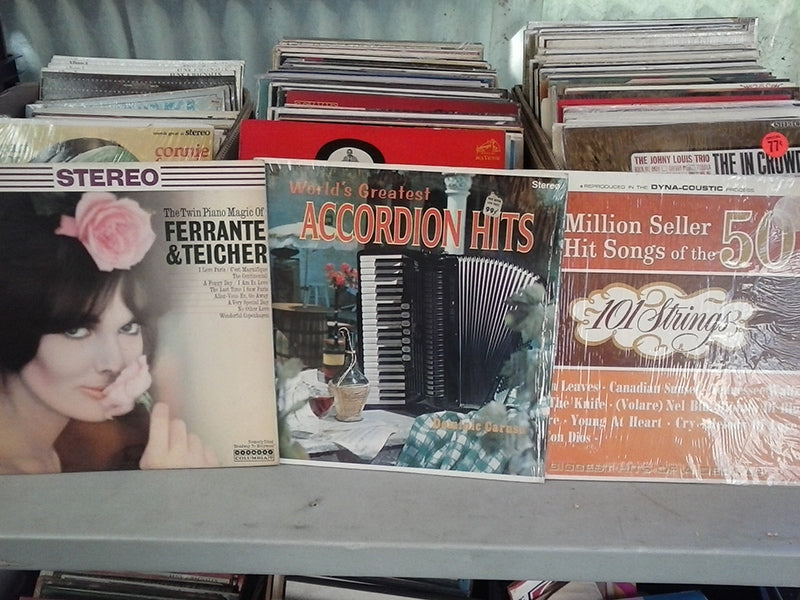The news occasionally carries a story about the World’s Worst Record Collection. The journalistic ball gets rolling when a blood clot of ancient LPs is offered to a record shop or a second-hand store and the alarmed proprietor runs to Twitter. These collections often include some combination of David Cassidy and the Partridge Family.
If my sister has read this far, she’s gone ballistic. “David’s records are the cornerstone of any serious music library,” she says, in a quote I just wrote for her. My sister was in grade school when The Partridge Family debuted on TV. That’s all the explanation you need.
Mr. Cassidy’s frequent appearances among World’s Worst Record Collection contenders makes me wonder what records were in his collection. He was born in 1950; based on his discography, I’d guess his musically formative years were dominated by crewcut guys in sweaters, beach boys with surfboards, the British Invasion (the Beatles and the Hollies, not the Rolling Stones and the Animals), and the show tunes his stepmother, Shirley Jones, had mastered. I think he admired the blues – from a safe distance. His solo albums hint at his exposure to some pretentious arena rock. All that isn’t so bad. But the result – the music he made – was something I couldn’t tolerate.
It’s easy for me to make fun of Cassidy (when my sister isn’t around), but even if you consider him one of the Four White Male Horsemen of the Apocalypse (along with Sting, Barry Manilow, and Kenny G), there are plenty of people who would tell you to Shut. Up. These men have tens of millions of fans, people who are impervious to the opinions of critics and snobs like me. Pick your poison. There’s always somebody who will drink it and call it chardonnay.
How then can we define the World’s Worst Record Collection (hereinafter referred to as the WWRC)? The answer lies in a garage sale I stumbled across one recent summer in Portland, Oregon. There I found dozens of LPs (a true WWRC is hefty) which I’ve documented in this unretouched photo:

What you can see: Arthur Ferrante and Louis Teicher, The Twin Piano Magic of Ferrante & Teicher (1964); Dominic Caruso, World’s Greatest Accordion Hits (1968); 101 Strings, Million Seller Hit Songs of the 50s (1964); and the Johny Louis Trio, The In Crowd (1965), at one point in its existence on sale for 77¢. (Was “Johny” a typo? Inquiring minds want to know.)
What you can’t see: Various artists, Percussion for Playboys (1959); Ann Corio, Sonny Lester & His Orchestra, How to Strip for Your Husband (1963); and at that point I stopped taking notes because I was afraid the earth was about to open beneath my feet.
This may have been the worst record collection in the history of records. Hoping for a scoop, I ventured from the driveway where the records were outgassing in the sun into the garage and the house. There was a room full of gleaming, vintage accordions. If I had also found a room full of banjos and another with bagpipes, I would’ve hit the trifecta. The part of the house that was open to the public was devoted to music, but though I saw many boom boxes and turntables, no one was playing any. I tried to find the owner, but I was told by the cheerful folks running the sale that he had “moved away.” Had he hired a company to do the clearing he couldn’t bring himself to do? Were his children ridding themselves of the objects they were afraid would end up at their houses or land them on Twitter?
The answer, my friend, is blowin’ in the wind. But the ranks of these rank records made me realize that you can’t judge a WWRC by the number of David Cassidy or Christopher Cross albums or by the presence or absence of “The Purple People Eater” or “Who Let the Dogs Out?” What you need for a true WWRC are uninspired interpreters of the original music as well as the themes that people pitch when they’re drunk, such as 101 violinists playing together like an army on maneuvers, or music to convince your wife to take off her clothes, which she was probably going to do anyway.
In short, what you need is a bunch of ill-conceived tribute albums. Welcome back to Lawrence Welk country.
They Don’t Make Life Like They Used To
We can always argue about the true nature of a WWRC, but one thing’s for sure: That era is over. Sure, in this century LPs have been resurrected, but given the increased costs of making them and purchasing them, no one is going to lay down on vinyl the contemporary equivalent of the debris I found at that yard sale. Crud like that will be downloads only. The WWRCs that will be unearthed in the coming decades will all be from the 20th century, when it seemed that anyone could throw a half-baked idea together and press it onto a petroleum by-product.
In “Only a Moment Ago,” David Cassidy asked, “Why has the music stopped? Where did all the happy people go?”
It’s not the music that’s stopped, David, it’s the vinyl avalanche of new bad records.
My sister would add, “Thank you for your service.”
Header image: from the editor’s collection.



